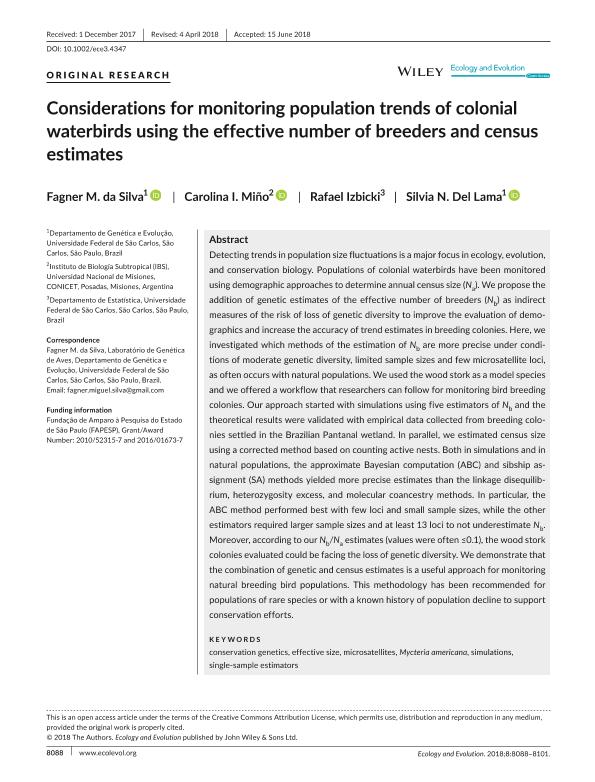Mostrar el registro sencillo del ítem
dc.contributor.author
Da Silva, Fagner M.
dc.contributor.author
Miño, Carolina Isabel

dc.contributor.author
Izbicki, Rafael
dc.contributor.author
Del Lama, Sílvia Nassif
dc.date.available
2019-08-26T20:19:38Z
dc.date.issued
2018-06
dc.identifier.citation
Da Silva, Fagner M.; Miño, Carolina Isabel; Izbicki, Rafael; Del Lama, Sílvia Nassif; Considerations for monitoring population trends of colonial waterbirds using the effective number of breeders and census estimates; Wiley; Ecology and Evolution; 8; 16; 6-2018; 8088-8101
dc.identifier.issn
2045-7758
dc.identifier.uri
http://hdl.handle.net/11336/82160
dc.description.abstract
Detecting trends in population size fluctuations is a major focus in ecology, evolution,and conservation biology. Populations of colonial waterbirds have been monitoredusing demographic approaches to determine annual census size (Na). We propose theaddition of genetic estimates of the effective number of breeders (Nb) as indirectmeasures of the risk of loss of genetic diversity to improve the evaluation of demographics and increase the accuracy of trend estimates in breeding colonies. Here, weinvestigated which methods of the estimation of Nb are more precise under conditions of moderate genetic diversity, limited sample sizes and few microsatellite loci,as often occurs with natural populations. We used the wood stork as a model speciesand we offered a workflow that researchers can follow for monitoring bird breedingcolonies. Our approach started with simulations using five estimators of Nb and thetheoretical results were validated with empirical data collected from breeding colonies settled in the Brazilian Pantanal wetland. In parallel, we estimated census sizeusing a corrected method based on counting active nests. Both in simulations and innatural populations, the approximate Bayesian computation (ABC) and sibship assignment (SA) methods yielded more precise estimates than the linkage disequilibrium, heterozygosity excess, and molecular coancestry methods. In particular, theABC method performed best with few loci and small sample sizes, while the otherestimators required larger sample sizes and at least 13 loci to not underestimate Nb.Moreover, according to our Nb/Na estimates (values were often =0.1), the wood storkcolonies evaluated could be facing the loss of genetic diversity. We demonstrate thatthe combination of genetic and census estimates is a useful approach for monitoringnatural breeding bird populations. This methodology has been recommended forpopulations of rare species or with a known history of population decline to supportconservation efforts.
dc.format
application/pdf
dc.language.iso
eng
dc.publisher
Wiley

dc.rights
info:eu-repo/semantics/openAccess
dc.rights.uri
https://creativecommons.org/licenses/by-nc-nd/2.5/ar/
dc.subject
Conservation Genetics
dc.subject
Effective Size
dc.subject
Microsatellites
dc.subject
Mycteria Americana
dc.subject
Simulations
dc.subject
Single-Sample Estimators
dc.subject.classification
Genética y Herencia

dc.subject.classification
Ciencias Biológicas

dc.subject.classification
CIENCIAS NATURALES Y EXACTAS

dc.title
Considerations for monitoring population trends of colonial waterbirds using the effective number of breeders and census estimates
dc.type
info:eu-repo/semantics/article
dc.type
info:ar-repo/semantics/artículo
dc.type
info:eu-repo/semantics/publishedVersion
dc.date.updated
2019-08-20T14:07:09Z
dc.identifier.eissn
2045-7758
dc.journal.volume
8
dc.journal.number
16
dc.journal.pagination
8088-8101
dc.journal.pais
Reino Unido

dc.description.fil
Fil: Da Silva, Fagner M.. Universidade Federal do São Carlos; Brasil
dc.description.fil
Fil: Miño, Carolina Isabel. Consejo Nacional de Investigaciones Científicas y Técnicas. Centro Científico Tecnológico Conicet - Nordeste. Instituto de Biología Subtropical. Instituto de Biología Subtropical - Nodo Puerto Iguazú | Universidad Nacional de Misiones. Instituto de Biología Subtropical. Instituto de Biología Subtropical - Nodo Puerto Iguazú; Argentina
dc.description.fil
Fil: Izbicki, Rafael. Universidade Federal do São Carlos; Brasil
dc.description.fil
Fil: Del Lama, Sílvia Nassif. Universidade Federal do São Carlos; Brasil
dc.journal.title
Ecology and Evolution
dc.relation.alternativeid
info:eu-repo/semantics/altIdentifier/url/https://onlinelibrary.wiley.com/doi/abs/10.1002/ece3.4347
dc.relation.alternativeid
info:eu-repo/semantics/altIdentifier/doi/http://dx.doi.org/10.1002/ece3.4347
Archivos asociados
